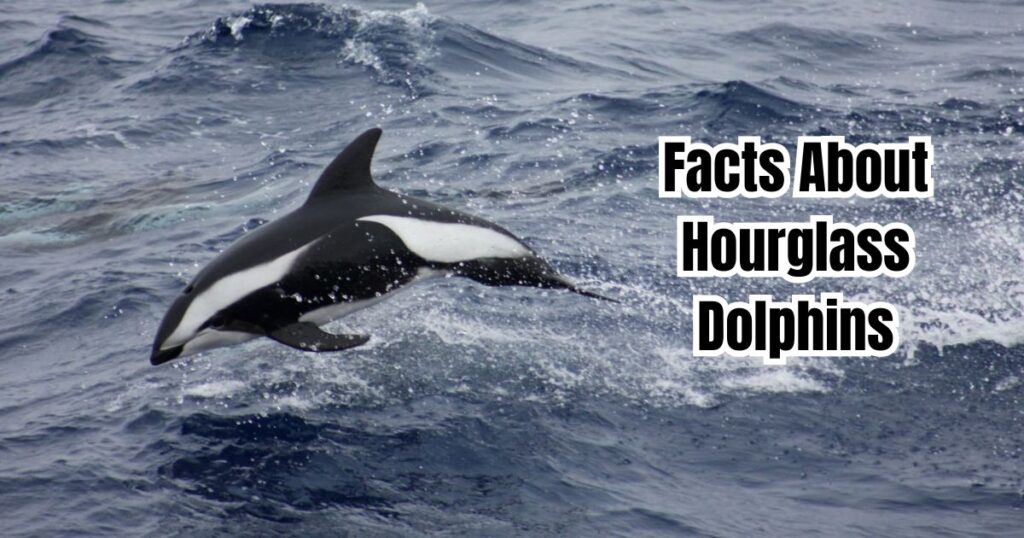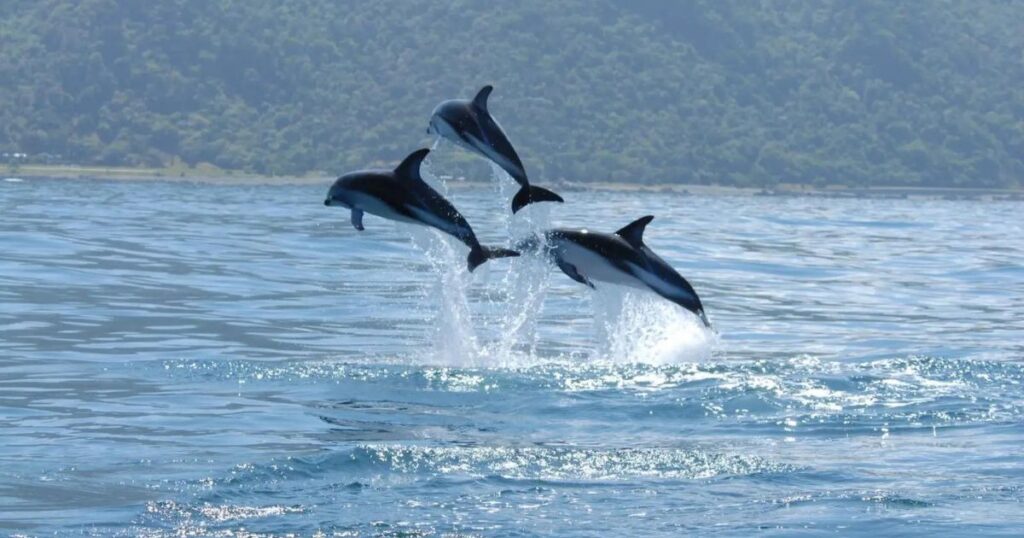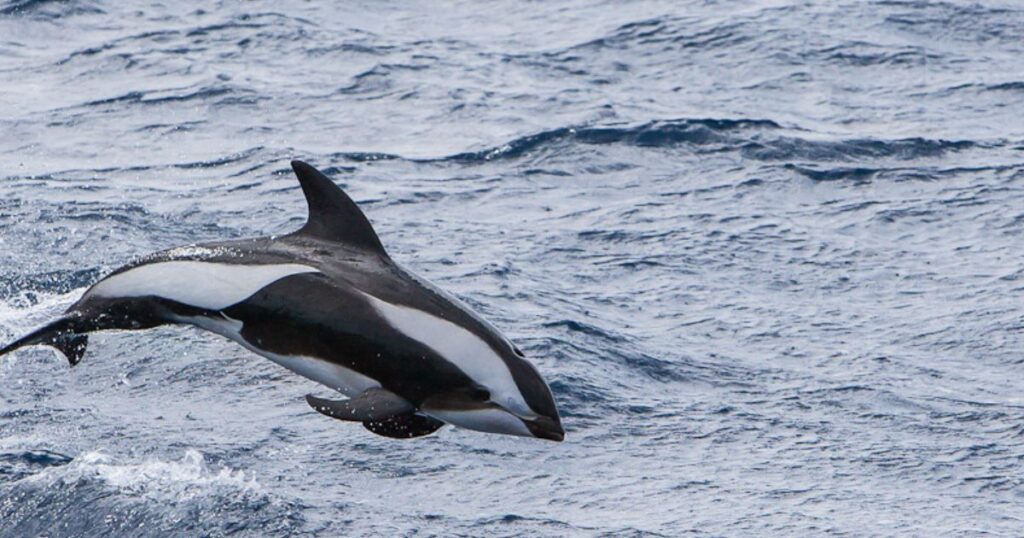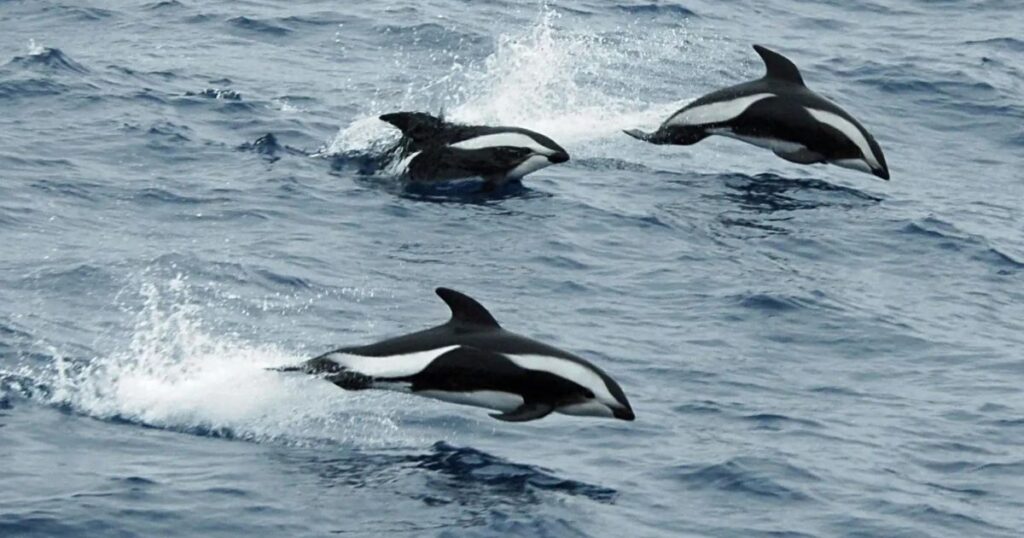
Facts About Hourglass Dolphins: Scientists and marine aficionados have long been captivated by hourglass dolphins, who have mysteriously appeared in the chilly Antarctic seas and have fascinating black and white patterns.
These unusual animals are members of the mammalian class and possess a number of fascinating traits and adaptations that allow them to survive in some of the most hostile places on Earth. To learn more about hourglass dolphins, let’s explore their world.
Table of Contents
- 1 How Long Do Hourglass Dolphins Live?
- 2 What Does The Hourglass Dolphin Eat?
- 3 What Color Are Hourglass Dolphins?
- 4 Where do Hourglass Dolphins Live?
- 5 Hourglass Dolphin Adaptations
- 6 Hourglass Dolphin Size
- 7 How Does The Hourglass Dolphin Survive In Antarctica?
- 8 Hourglass Dolphin Behavior
- 9 Hourglass Dolphin Threats
- 10 10 Surprising Facts About Hourglass Dolphins
- 11 Facts About Hourglass Dolphins for Kids
- 12 Conclusion: Facts About Hourglass Dolphins
How Long Do Hourglass Dolphins Live?
Scientists are still unsure about the hourglass dolphins’ life expectancy. They are thought to be able to survive in their native habitat for several decades, provided there are no serious threats, however, exact statistics are not yet known.
What Does The Hourglass Dolphin Eat?
Diverse aquatic creatures are consumed by hourglass dolphins to satisfy their nutritional requirements, demonstrating their varied palette. Their main food intake is made up of:
Fish: A variety of fish species present in their environment are the prey of these dolphins. Little schooling fish like lanternfish, herring, and mackerel are common prey items.
Squid: Hourglass dolphins also often consume squid in their diet. Hourglass dolphins are skilled at catching these energetic and protein-rich cephalopods using their nimble swimming abilities.
Crustaceans: Shrimp and krill are among the crustaceans that hourglass dolphins consume. These tiny, shrimp-like creatures are common in Antarctic seas and provide a vital food supply for a variety of marine life.
Plankton: Hourglass dolphins have been seen feeding among plankton blooms, despite their rarity. Tiny creatures like phytoplankton and zooplankton, which are crucial links in the marine food chain, make up plankton.
Even though plankton might not make up a large amount of their diet, hourglass dolphins are quite flexible when it comes to utilizing the food sources that are readily available to them. [Facts About Hourglass Dolphins]
Since hourglass dolphins are opportunistic eaters, they will eat any available food in their surroundings. The range and number of prey species may influence their hunting tactics.
For instance, hourglass dolphins may use cooperative hunting strategies to capture schooling fish, gathering them in close quarters before coordinating a concerted attack.
Below is a simplified table outlining the dietary preferences of hourglass dolphins:
| Dietary Component | Examples |
| Fish | Lanternfish, herring, mackerel |
| Squid | Various species of squid |
| Crustaceans | Shrimp, krill |
| Plankton | Phytoplankton, zooplankton |

What Color Are Hourglass Dolphins?
These magnificent animals have a body that is mostly black with noticeable white spots that give them the recognizable hourglass shape down their flanks.
This distinct coloring helps with concealment and might be used as a means of interpersonal communication.
Where do Hourglass Dolphins Live?
The scientific name for hourglass dolphins is Lagenorhynchus cruciger, and they are mostly found in the icy seas of the Antarctic and sub-Antarctic.
These dolphins have adapted effectively to the bitterly cold climate that predominates in these regions. On the other hand, reports of hourglass dolphin sightings as far north as the coastlines of Chile suggest that their range may be rather flexible.
The fact that hourglass dolphins are the only dolphin species with dorsal fins known to exist below the Antarctic convergence point is one of its most amazing characteristics.
This distinguishing feature highlights their specific adaptability to the cold waters of the Southern Ocean and sets them distinct from other cetaceans. [Facts About Hourglass Dolphins]
Hourglass Dolphin Adaptations
Specialized adaptations are necessary to survive in the cold Antarctic climate, and hourglass dolphins have developed a number of amazing traits to flourish in these extreme settings.
Thick Blubber coating: To protect themselves from the frigid Antarctic seas, hourglass dolphins have a thick coating of blubber under their skin. During times of fasting, this fat layer supplies vital energy reserves and aids in regulating the body temperature. [Facts About Hourglass Dolphins]
Streamlined Bodies: The streamlined bodies of these dolphins help them glide through the water more effectively by reducing drag. They can move quickly and elegantly in freezing waters thanks to their hydrodynamic design, which also helps them seek and avoid predators.
Strong Muscles: Hourglass dolphins have strong muscles, especially in their caudal and dorsal areas, which allow them to swim with remarkable agility and speed. This physical power is necessary for hunting, avoiding predators, and navigating the ever-changing oceanic environment.
Respiratory Adaptations: It might be difficult to keep up respiratory health while living in frigid waters. The ability to effectively draw oxygen from the cold Antarctic seas has allowed hourglass dolphins to maintain extended dives and feeding sessions without endangering their ability to breathe.
Social Behavior: Hourglass dolphins’ ability to survive in Antarctic waters is also influenced by their social structure. They move in cohesive groups most of the time, which helps to protect each other from predators and increases their success at foraging by using cooperative hunting techniques.

Hourglass Dolphin Size
These amazing animals may reach lengths of six feet and weights of up to 265 pounds, demonstrating their powerful physique and menacing presence in their natural environment.
How Does The Hourglass Dolphin Survive In Antarctica?
In order to survive and prosper in the harsh Antarctic climate, hourglass dolphins have evolved a variety of survival techniques.
Their fat coat facilitates their effective thermoregulation, which keeps their body temperature stable in icy waters.
Their group dynamics and social behavior may also improve hunting effectiveness and provide safety from predators. [Facts About Hourglass Dolphins]
Hourglass Dolphin Behavior
Hourglass dolphins are known for their intricate social patterns. They often travel in groups of ten or so, while bigger gatherings of up to 100 animals have been seen.
They regularly do acrobatic acts and ride waves created by larger animals or passing boats. They are renowned for their lively disposition.
Hourglass Dolphin Threats
Despite the International Union for Conservation of Nature’s (IUCN) current classification of hourglass dolphins as Least Concern, there might soon be risks to this species.
Changes in ocean currents and temperatures brought on by climate change may interfere with their migratory habits and food supply.
Moreover, persistent hazards to their populations come from unintentional entanglement in fishing gear and marine pollution. [Facts About Hourglass Dolphins]

10 Surprising Facts About Hourglass Dolphins
- Distinctive Appearance: Hourglass dolphins may be easily identified from other dolphin species because of their unique black and white hourglass pattern on their bodies. [Facts About Hourglass Dolphins]
- Cold-Water Dwellers: These dolphins show off their amazing adaption to one of the harshest habitats on Earth by living in the chilly seas of the Antarctic and sub-Antarctic.
- Elusive Creatures: Despite their remarkable look, hourglass dolphins are surprisingly cautious and secretive animals who frequently avoid close encounters with people and boats.
- Social Butterflies: Butterflies with a social nature: Although they may appear timid, hourglass dolphins are actually quite gregarious creatures. They can travel in groups of up to 100 people and participate in fun activities such as jumping and riding waves.
- Swift Swimmers: Hourglass dolphins can move quickly through the freezing waters of the Antarctic because of their powerful muscles and streamlined bodies, which allow them to attain speeds of up to 14 miles per hour.
- Mysterious Mating: Scientists are still unsure of many aspects of hourglass dolphin mating behavior, such as the precise age at which the dolphins attain sexual maturity and their mating rituals.
- Diverse Diet: Hourglass dolphins have a diverse diet that includes fish, squid, crabs, and even plankton, demonstrating their resilience and ingenuity while living in a hostile environment.
- Wonders of Migration: Although the whole span of these dolphins’ migratory range is yet unknown, they show north-south migration patterns, following the West Wind Drift, which takes them to warmer seas during the winter.
- Conservation Status: The IUCN currently lists hourglass dolphins as Least Concern, but scientists are always on the lookout for any threats like habitat loss and climate change.
- Scientific Significance: Hourglass dolphins are among the least researched dolphin species, yet they are important to marine ecosystems because they are markers of the health of the water and help scientists comprehend Antarctic biodiversity.
Facts About Hourglass Dolphins for Kids
Black and White Beauties: Hourglass dolphins resemble a natural tuxedo due to their gorgeous black bodies with white spots that make an hourglass pattern.
Chilly Home: These dolphins inhabit some of the planet’s coldest seas, where penguins swim and icebergs float. They truly are excellent at maintaining warmth in the icy waters of the Antarctic.
Underwater Acrobats: Hourglass dolphins like showcasing their acrobatic abilities by jumping out of the water and circling around, much like circus acts do. It resembles taking in a dolphin dance celebration!
Team Players: Hourglass dolphins are gregarious and frequently congregate in large gatherings with their loved ones. They like chasing one another through the waves and playing games.
Swift Swimmers: These dolphins can reach up to 14 miles per hour in the ocean, making them speed demons. They resemble aquatic Olympic sprinters!
Mysterious Love Lives: There is still much that scientists don’t know about how hourglass dolphins discover their true love and raise a family. It resembles cracking a complex undersea mystery!
Delicious Diners: Hourglass dolphins eat a wide variety of foods, including fish, squid, and even microscopic organisms known as plankton. They have no taste preferences!
Travelers of the Sea: Hourglass dolphins take a vacation to warmer seas during the winter, although they don’t really pack their luggage. Like voyagers traveling underwater, they follow the currents.
Helpers of the Ocean: Despite their small size, these dolphins are vital to maintaining the health of the ocean. They contribute to maintaining the equilibrium of marine life by consuming fish and other organisms.
Ocean Heroes: Hourglass dolphins, who silently glide through the chilly seas like marine superheroes, serve as a constant reminder to everyone to preserve and value our priceless oceans.
Conclusion: Facts About Hourglass Dolphins
To sum up, hourglass dolphins are incredible representatives of the Antarctic waters, demonstrating adaptability and tenacity in the face of hardship.
It is essential that we, as stewards of our seas, never stop researching and safeguarding these amazing animals in order to guarantee their continued existence for future generations.

Mr. Das, a certified pharmaceutical scientist, holds a Bachelor of Science in Pharmaceutical Sciences and passionately contributes to dolphin conservation as a member of the committee in Bangladesh.


